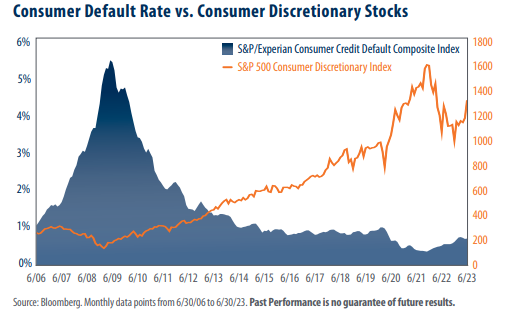
View from the Observation Deck
For today’s post, we thought it would be informative to compare the rate of consumer defaults across auto loans, first mortgages, second mortgages, and bankcards to the prices of the S&P 500 Consumer Discretionary Index, over time. We use the S&P/Experian Consumer Credit Default Composite Index as a proxy for the former set of observations.
With a total return of 34.65% year-to-date through 8/1/23, the S&P 500 Consumer Discretionary Index boasts the third-highest total return of the 11 major sectors that comprise the S&P 500 Index.
In our last blog post (click here for “Consumer Checkup: Aisle 7”) we wrote about the various factors that could be contributing to the performance of the consumer discretionary sector. We also shared our view that a healthy consumer could reduce the chances of a notable, extended recession in the U.S. economy.
The S&P/Experian Consumer Credit Default Composite Index stood at a reading of 0.72% on 6/30/23 (most recent data).
One important aspect of overall consumer health is the rate at which they are defaulting on their debt obligations. The S&P/Experian Consumer Credit Default Composite Index (“Index”) measures the default rate across auto loans, first and second mortgages, and bankcards. At its current level, the index sits well below its 1.61% average since inception (July 2004) and significantly below its all-time high of 5.51% set in May 2009. The all-time low for the index was 0.37% which was reached on 11/30/21.
Takeaway
Consumer defaults, as measured by the S&P/Experian Consumer Credit Default Composite Index, stood at 0.72% on 6/30/23. While it is true that defaults have risen from recent alltime lows, they are not alarmingly high, in our opinion. At current readings, the index reflects default rates that are well below their historical average of 1.61% and even further below their all-time high of 5.51%. We will continue to monitor the rate of defaults among consumers and report any notable changes.



